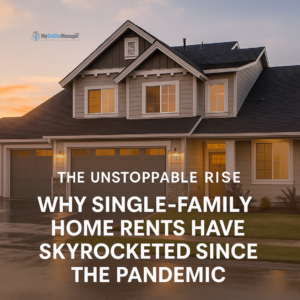Across the United States, single-family rental prices have surged 41% higher than their pre-pandemic levels, according to new data reported by The Hill. While multifamily apartment rents have also climbed, they’ve increased at a slower pace of 26% during the same period.
This widening gap between single-family and multifamily rental prices is reshaping the rental housing landscape, raising questions about affordability, demand, and long-term sustainability in the U.S. housing market.
A Pandemic-Driven Shift in Housing Preferences
The pandemic dramatically shifted how Americans view housing. With more people working remotely, the appeal of spacious homes with private yards, offices, and garages skyrocketed.
Single-family homes became the preferred choice for renters who wanted more space and privacy, fueling competition and rent hikes that have continued into 2025.
At the same time, apartment construction rebounded faster, with multifamily developers adding thousands of new units to the market. This supply helped slow down rent growth in urban centers, but single-family rentals remain constrained.
Why Single-Family Rents Continue to Outpace Apartments
-
Low Housing Supply: New single-family rental construction hasn’t caught up with demand. Most builders focused on for-sale housing, not rentals, leaving a shortage of available units.
-
High Mortgage Rates: With mortgage rates hovering around record highs, many would-be buyers have turned to renting instead, pushing rental demand even higher.
-
Lifestyle Shifts: Families and professionals who once aimed to buy are staying in rentals longer. The “renting by choice” trend means renters are prioritizing comfort and flexibility over ownership.
-
Investment Dynamics: Institutional investors have purchased thousands of single-family homes nationwide, particularly in states like Texas, Florida, and Arizona, reducing available inventory and influencing pricing trends.
Where the Price Gap Is Most Pronounced
According to national data cited by The Hill, the premium for renting a single-family home is about 20% higher than renting an apartment.
In large metros like Phoenix, Atlanta, and Tampa, single-family rents have jumped far beyond the national average, in some cases nearly doubling since 2020.
This regional imbalance underscores a broader challenge: while multifamily housing is expanding rapidly, suburban and low-density areas remain underdeveloped, keeping single-family rents high.
The Impact on Renters
For tenants, this shift means fewer affordable options especially for families or individuals seeking space.
-
A single-family home that once rented for $1,500 before the pandemic might now cost over $2,100.
-
Many renters are being priced out of neighborhoods they could once afford.
-
Suburban migration, driven by affordability, is now being met with rising rents even in outer metro areas.
This affordability crunch is prompting some renters to reconsider apartment living or co-living arrangements to manage costs.
What This Means for Property Managers
For property managers and leasing professionals, the new market reality presents both opportunity and responsibility:
-
Higher Revenue Potential: With single-family homes commanding higher rents, property owners and managers can capture increased revenue but must balance pricing with tenant retention.
-
Rising Tenant Expectations: Higher rent comes with higher service expectations. Quick maintenance response, professional communication, and quality upkeep will determine renewals.
-
Turnover Risk: As affordability tightens, tenants are more likely to move if they feel overcharged or underserviced. Preventing turnover through proactive service is key.
-
Marketing Focus: Emphasize the lifestyle value of single-family rentals space, privacy, and flexibility to justify pricing and differentiate from apartments.
Long-Term Outlook
Experts warn that without an expansion of single-family rental supply, affordability pressures could worsen.
Even if rent growth moderates in 2025, the elevated baseline means housing will remain expensive for years.
However, as mortgage rates gradually ease, some renters may pivot toward homeownership again potentially balancing rental demand later this decade.
In the meantime, property managers who stay adaptive using data-driven pricing, transparent communication, and efficient turnover systems will be best positioned to thrive in this evolving landscape.
In Summary:
-
Single-family home rents are 41% higher than pre-pandemic.
-
Apartments have increased 26%.
-
Supply shortages, lifestyle shifts, and investor influence continue to drive up costs.
-
Property managers and owners must align value and service to maintain occupancy and trust.
Source: The Hill – “Rents for single-family homes 41% higher than pre-pandemic rents”

